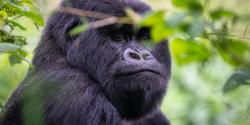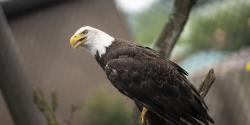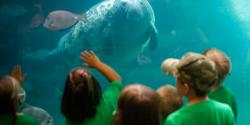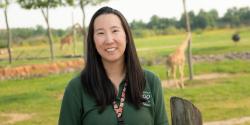NOTE TO MEDIA: Photos and video are available through this link. Photo credits are found in the file names (example: Amanda Carberry, Columbus Zoo and Aquarium).
Powell, OH — The Columbus Zoo and Aquarium is excited to announce a groundbreaking achievement: four male weedy seadragons (Phyllopteryx taeniolatus) are currently carrying eggs—a first for any public aquarium in the world. This remarkable achievement highlights the expertise and dedication of the Zoo’s Shores & Aquarium care team in providing optimal conditions for these delicate and mysterious creatures while advancing the understanding and conservation of the species.
Weedy seadragons, close relatives of seahorses, are known for their distinctive reproductive process in which males—not females—carry fertilized eggs. The successful transfers of eggs from females to the tails of four different males mark a major step forward in understanding the reproductive behavior of this species and supporting its long-term conservation.
“This is an extraordinary accomplishment that reflects the expertise of our Shores & Aquarium team,” said Tom Schmid. “Achieving this kind of success with such a sensitive species speaks volumes about the care, knowledge, and dedication and care our team brings to advancing animal wellbeing and conservation every single day.”
Hatches are estimated to be between May 30th and June 16th, and the Animal Care team has moved the soon-to-be fathers behind the scenes to keep a closer eye on them and the eggs. To date, 20 have hatched.
The fragile inch-long hatchlings will be raised for at least one year behind the scenes, where the expert Animal Care team continues to provide all aspects of care for the babies. The Care team reports that the baby seadragons have a voracious appetite and are eating approximately 9,000 baby mysis shrimp and 18,000 copepods (planktonic crustaceans) per week. The care team remains cautiously optimistic that the young seadragons will survive and thrive. While a few were born prematurely, this is not uncommon. Typically, only five percent of seadragons survive their first year in their native range.
While not officially classified as threatened, weedy seadragons are considered vulnerable due to warming oceans and unsustainable fishing practices. Native to the southern and eastern coasts of Australia, weedy seadragons are famously challenging to breed in professional care. With long, slender bodies and leaf-like appendages, they blend seamlessly into kelp and seaweed habitats. They can grow up to 18 inches in length and feed using their tube-shaped snouts—suctioning up small prey like mysid shrimp, much like a straw. Their natural camouflage makes them difficult to observe in their native range by both predators and researchers and adds to the importance of successful breeding programs under professional care.
Adding to the challenge of breeding is their elaborate mating ritual. Male and female seadragons mirror each other's movements with tails gracefully curved away. During a synchronized rise in the water column, the female deposits eggs onto the underside of the male's tail—a unique process distinct from seahorses, which carry eggs in a pouch. The male fertilizes the eggs and cares for them for six to eight weeks until they hatch.
Because they are rarely seen in their native range and challenging to study, breeding them successfully under professional care provides important insight into their biology and long-term survival.
“In the world of aquatic animal care, this is a remarkably rare and meaningful milestone,” said Megan Brown, PhD, director of Population Management Strategy for the Association of Zoos and Aquariums. “Weedy seadragons are among the most challenging marine species to breed, and observing multiple males brooding eggs within the same timeframe offers exciting new insight into their complex reproductive biology—something few facilities have accomplished.”
This new milestone builds on the Zoo’s success in 2024, when a weedy seadragon male hatched more than 20 baby seadragons —also known as “fry”—following a successful egg transfer. It was the first time the Columbus Zoo had hatched weedies, placing the organization among only a few North American institutions to do so. A second egg transfer was also observed but did not result in hatching, providing further insight into the delicacy of this reproductive process.
The young seadragons from 2024 have now reached the size of the adults and are thriving in the habitat with the rest of the Zoo’s seadragon population. The knowledge gained from that successful hatching and rearing experience has contributed directly to the Zoo’s ongoing advancements in seadragon care and breeding.
“Each day caring for these animals gives us a chance to learn something new,” said Becky Ellsworth, Curator of the Shores and Aquarium region at the Columbus Zoo. “From subtle behaviors to environmental preferences, these opportunities help us fine-tune their care and contribute meaningful insights that only come through hands-on experience.”
For additional information about the Columbus Zoo’s conservation initiatives, educational programs, events, and more, follow the Zoo’s social media accounts on Facebook, Instagram, TikTok, and LinkedIn, and visit us at ColumbusZoo.org.









